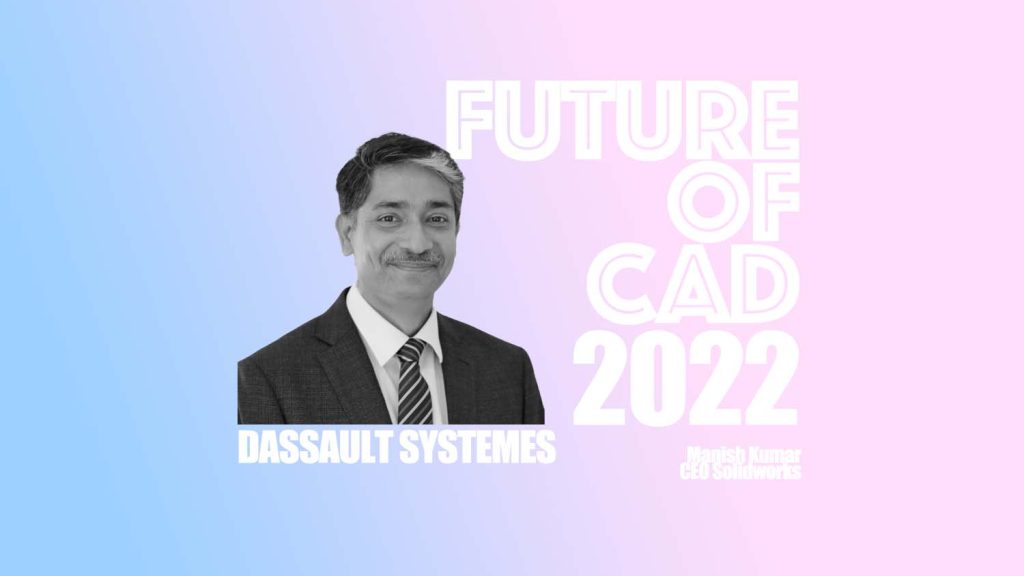 Future of CAD – DASSAULT SYSTEMES
Future of CAD – DASSAULT SYSTEMES
Time stands still for no-one – including design software, so we asked Manish Kumar, CEO Solidworks, for their opinions on the direction of CAD, ranging from initial concepting workflows, the impact of Artificial Intelligence (AI), and even how we keep it up to date
Q
How do you imagine sketch tool environments evolving?
Sketching is an undeniably, and perhaps the most, important feature in the creation of new components, and it will remain so in the future. At the same time, there are new design workflows that are evolving where sketching is becoming less important.
Two essentially sketch-less workflows are the use of direct edit methods for the reuse and/or modification of existing components, and the adoption of Sub-D modeling with its use of shape primitives and push-pull manipulation of the geometry to create highly curved organic designs
One very important workflow where sketching is evolving is in the reuse of freehand sketches, ink, or imagery as the starting point or reference for designs. Making use of existing artwork to create sketch entities will be a great time saver for industrial designers. You can also expect to see the increasing use of AI to anticipate the needs of the user during repetitive tasks and recognise the recreation of similar sketches by dissecting past designs and automatically notify users that a very similar sketch already exists.
Q
How do you imagine designers will interact with CAD UIs in the future?
Today, the mouse has delivered the best balance of speed, precision and ergonomics, but as devices evolve and develop this is changing. For Solidworks, the use of touch or mouse isn’t an either-or decision, it’s about what makes sense for a particular device and workflow. For many of our users, touch adds value and enhances their design workflows.
We are already delivering solutions where the UI is optimised based on the expected user device and workflows. Our latest web-based design tools can be driven equally well either through touch or a mouse.
For consumer-focused CAD, the adoption of touch interfaces is even more important as consumer devices move away from the mouse and toward the touch. HomeByMe is a modern touch-focused design product where users can design their home interiors, and our latest app, MakeByMe, was developed with touch first/mobile-first approach. It has broken the tyranny of mouse and keyboard while providing makers the ability to create furniture from anywhere, using any device.
Q
Downloading regular updates to a 3D CAD package is more common – is this the way all 3D CAD is now heading?
We continually deliver functional updates and improvements as fast as possible. For our cloud portfolio, where everyone is on the same version all the time, this is the only way.
Yet, there are certain industry segments, such as defense or life sciences which, due to significant regulatory and compliance reasons, have very stringent design tool certification processes. These companies cannot continually update their design solutions without incurring a significant time and financial cost. We will continue to serve our customers by offering both choices.
Q
How do you view the increase in AI impacting design tools the most?
While a designer’s passion is to come up with creative ideas and solutions, we have to recognise that the CAD design process can include repetitive, boring tasks. We see AI playing a huge role in augmenting a designer’s workflows by carrying out mundane repetitive tasks, freeing up time to be more creative.
Browser-based tools in 3D Creator, 3D SheetMetal Creator, and 3D Sculptor have AI-based Design Assistants built into them. Machine learning algorithms learn from the way the user designs and reduces or automates repetitious tasks, such as selecting edges, inserting mates, or predicting new sketch entities and giving users an option to insert them automatically.
Another example of how AI/machine learning is automating tedious tasks is in the reading of PDFs in Solidworks Inspection which automatically recognises the dimensions to help with proper inspection operations.
Q
How do you imagine the users of your software will change and how do you see this impacting the software?
Today 3D has been democratised to the point that it has become a universal language to collaborate and share ideas between all age groups and geographies. Our suite of tools from Apps for Kids to Solidworks is available for all and we continue to evolve this and provide efficient ways for our customers to tackle problems, beginners, or experiences.
It is no longer just about providing a product, but also delivering a great experience around this – it must be aesthetically pleasing, reliable, robust, and perform well during regular use. It should also be priced correctly, which means it must be produced with the least number of resources, be sustainable, and be able to capture the user’s imagination right from the first look. Finally, it should support delivering work on time. For this reason, we ensure that Solidworks’ solutions are delivered to use in new and holistic ways.
Q
When will CAD software be able to take advantage of modern graphics APIs for better 3D performance and advanced features like GPU ray tracing?
We work closely with all our partners like graphics partners, AMD, Intel, and Nvidia to make sure we are always taking advantage of the latest available technologies. By doing so, recently we have re-architectured our graphics pipeline to take advantage of these emerging technologies. So, in a way, this is already happening while we speak.






